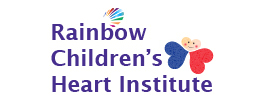The Rastelli operation is used for repairing the d-transposition of the great vessels through pulmonary stenosis and ventricular septal defect. It has also been used for treating a number of congenital heart defects associated with overriding of the aorta and two ventricles with pulmonary atresia and pulmonary stenosis. This is a complex operation that requires specialists in cardiology. At the Rainbow Children’s Heart Institute, we have a team of experienced and qualified medical professionals who provide the best care to your child.
Services
The Rainbow Children’s Heart Institute is going to provide the following services using the Rastelli operation:
- Ventricular Septal Defect (VSD)
- Right Ventricular Outflow Tract Obstruction (RVOTO)
- Subpulmonary stenosis
- Pulmonary stenosis
- Pulmonary atresia
- Double Outlet Right Ventricle (DORV), or overriding aorta, or dextro-Transposition of the Great Arteries
FAQs
- What is the surgical procedure of the Rastelli Operation?
To perform the Rastelli repair, aortic cross-clamping and cardiopulmonary bypass are required. A right ventriculotomy is used for visualizing the ventricular septal defect. The first step is exercising and obstructive right ventricular muscle. Then, a large intraventricular baffle is sutured that closes the ventricular septal defect. The left ventricular outflow is redirected to the more anteriorly placed aortic valve. For achieving the right continuity from the right ventricular to the pulmonary artery, a valved homograft conduit is used. Doctors can use the transesophageal echocardiography for assessing the adequacy of the repair. The time required to complete the repair through aortic cross-clamp and cardiopulmonary bypass can be anything between moderate to long.
- What are the postoperative considerations for the Rastelli operation?
The Rastelli operation is extensive and, in some cases, can cause early hemodynamic instability. Invasive monitors are used after the operation like central venous, arterial, and left atrial catheters. For monitoring the cardiac output, an oximeter catheter is used. For hemodynamic management, vasoactive infusions are used including dobutamine or dopamine, nitroprusside, milrinone, epinephrine, and phenoxybenzamine. Unobstructed and free blood flow is required from the left to right ventricle for satisfactory postoperative hemodynamics. If there is an obstruction in any of the outflow tract, it can lead to ventricular failure. The Rastelli operation can be defined more and better to a patient by best cardiothoracic surgeon in hyderabad and you can consult children heart hospital in hyderabad to know more.
Another postoperative complication to consider is Arrhythmia. To make sure that the child is safe, temporary atrioventricular pacing capability should be kept available. In some cases, after the procedure, there can be some bleeding. It is also normal to have intracardiac pressures and arterial oxygen saturation after the operation. For an uncomplicated recovery, the child will have to stay in the hospital for one to two weeks after the Rastelli operation.
- What is the cause of the Tetralogy of Fallot?
In most cases, the cause of tetralogy is not known. However, it is a very common heart defect that is seen in children with DiGeorge syndrome or Down syndrome. In some cases, children with the tetralogy of Fallot will have other heart defects as well.
- How does the Tetralogy of the Fallot affect the heart?
In the normal situation, the left side of the heart is responsible for pumping blood to the body while the right side is responsible for pumping blood to the lungs. If your child has tetralogy of Fallot, the blood starts flowing across the hole (VSD). This means that the blood is now traveling from the right ventricle (right pumping chamber) to the left ventricle (left pumping chamber) and out into the body artery (aorta). This leads to an obstruction in the pulmonary valve from the right ventricle to the lung artery. This results in the prevention of the blood from being pumped into the lungs. In some cases like the pulmonary Atresia, the pulmonary valve is completely obstructed.
- How can the tetralogy of Fallot affect my child?
Infants and young children with the tetralogy of Fallot are often cyanotic (blue). The reason behind this is because of oxygen-poor blood being pumped through the hole in the wall between the left and right ventricle instead of pumping it to the lungs.
- How will the tetralogy of Fallot limit my child’s activities?
If there is any leftover leak or obstruction in the pulmonary valve after the repair, you child will have to limit their physical activities like competitive sports. If your child is having rhythm disturbances and decreased heart function, they might have to limit their physical activities more. However, if the tetralogy of Fallot has been repaired and there is no leak or obstruction in the pulmonary valve, your child will be able to participate in all the normal physical activities with little to no increased risk. Ask your pediatric cardiologist regarding whether your child needs any limits on the physical activities.
- After the treatment for the tetralogy of Fallot, what will my child need in the future?
Even after your child had treatment for repairing the tetralogy of Fallot, they will need regular follow-up appointments with a pediatric cardiologist. This means they will have lifelong regular follow ups with a cardiologist specialize in congenital heart defects. There can be some long-term problems like worsening or leftover obstruction between the lung arteries and the right pumping chamber. Also, children with repaired tetralogy of Fallot have an increased risk of arrhythmias, a heart rhythm disturbance. Sometimes, they must also feel fainting or dizziness. However, the general, long-term outlook is good. But, in some cases, children might need heart catheterization, medicines, and even more surgery.
